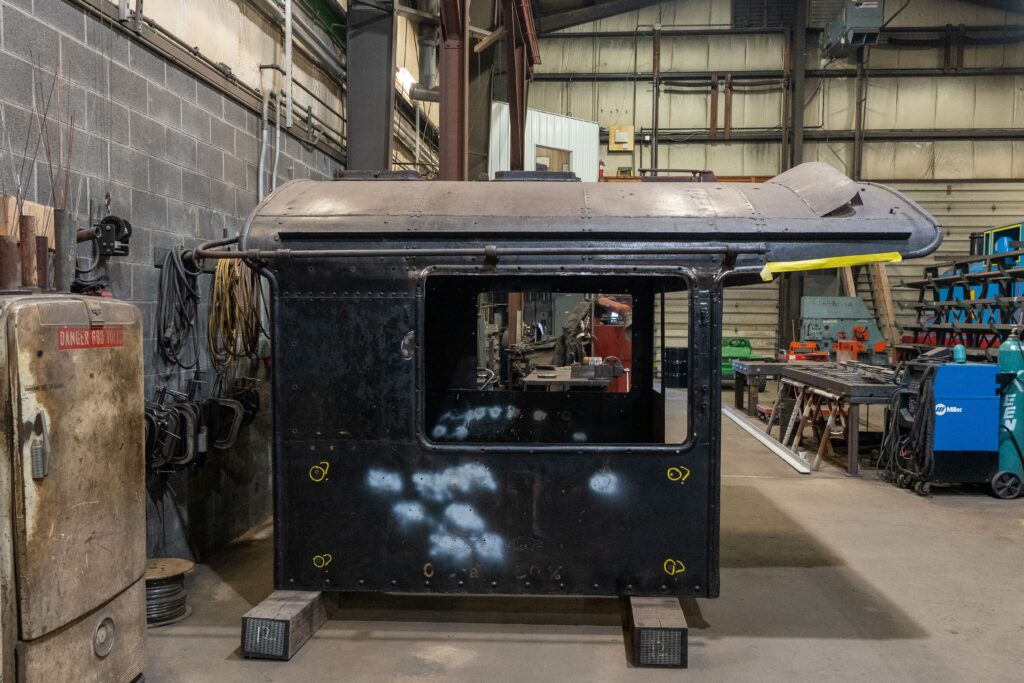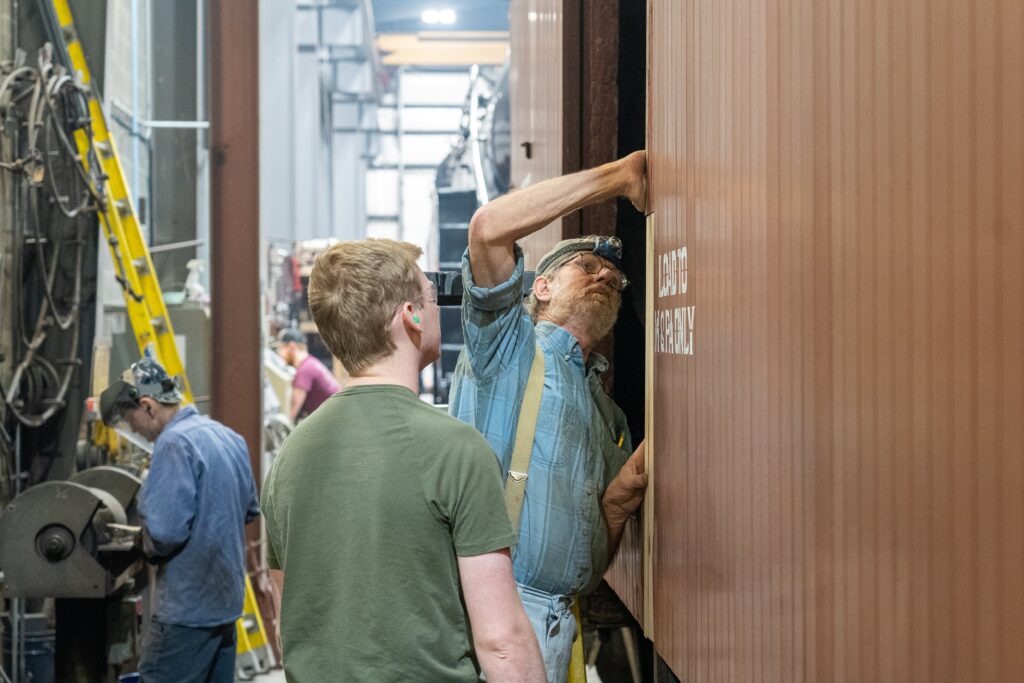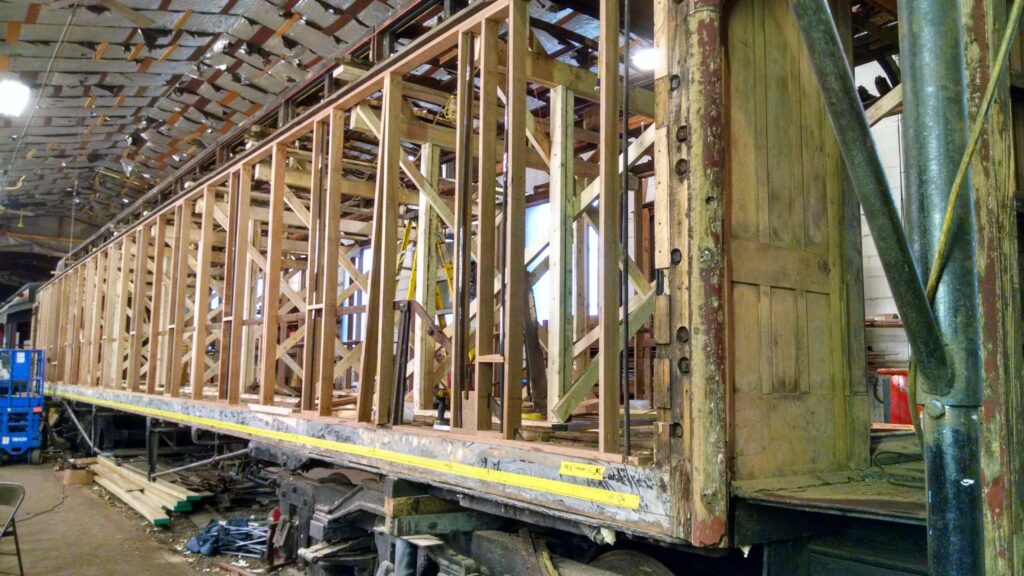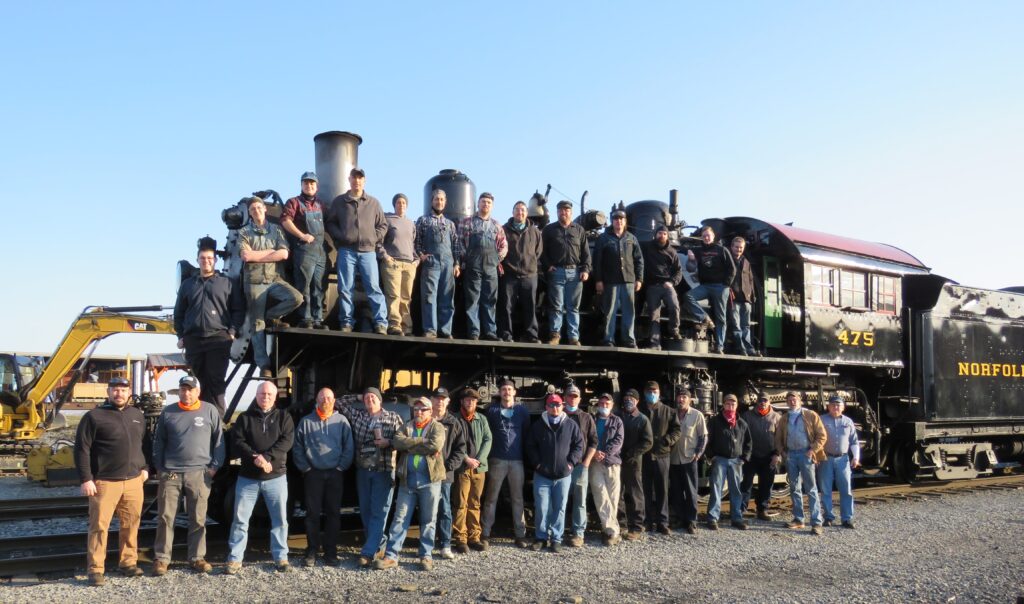Steam Locomotive Cosmetic Restoration: How We Help Preserve History

Sometimes you’ll see a steam locomotive that looks broken down and ready for the scrapyard. However, looks can be deceiving. The engine can be in good shape mechanically and all it needs is some cosmetic work and restoration.
By cosmetically restoring a steam locomotive, we can help extend the life of a piece of history. After reading this blog, you will learn how our process starts, the different steps in the restoration process, and some of the more common obstacles a restoration can go through.

It Starts With an Evaluation
The first step in any locomotive restoration project begins with an evaluation. The goal of a cosmetic restoration is to stabilize what is there, replace anything that is too far gone, and provide protection to make it look like new. Most restoration projects are field projects. However if the project becomes an operational restoration, then it can be moved to our Mechanical Shop.
After the initial consultation details are worked out, our team goes out to the project site for the evaluation of the locomotive or railcar. Several questions need to be answered before a project can begin.
Where is the Project Located?
A project’s location is an important factor. Is the locomotive at an outdoor or indoor facility? What are the weather conditions? Does it live in humid, snowy, or dry desert conditions?
This helps us make recommendations for different materials, paints, and coatings to help the restored locomotive look better and last longer in those unique environments.
Are There Any Future Plans for the Engine?
Knowing the client’s ideas for how they will use the locomotive or railcar in the future helps give the project direction. This is where we find out if the engine/railcar will be moved from an outdoor space into an indoor one or vice versa. Another question to ask is if the equipment will be transported to a different location—if it is then we can plan for that and be prepared.
As an example, in Jacksonville, FL, the city was considering legislation to declare Atlantic Coast Line No. 1504, a steam locomotive displayed at the Prime F. Osborn III Convention Center, a surplus property so it could be sold and transported to its new owners U.S. Sugar Corp. in Clewiston, FL.
Once in Clewiston, it will be renovated and used in limited service as a tourist train on U.S. Sugar’s property. This not only allows for the locomotive to be restored but will also keep it located in Florida.
What Type Of Cosmetic Restoration Are They Looking For?
There are two types of locomotive or railcar restoration: historic and aesthetic.
Historic restoration is when the locomotive is restored to exact historical details based on archival research or images. We always ask the client what standard of historical accuracy they’re looking for. If the client is a museum, then they will want a museum-quality restoration.
The other type is aesthetic restoration. This is used more for privately owned display pieces, like outside a restaurant or store. One of the main differences is it doesn’t need to be as accurate, there is some flexibility. It all depends on what the client wants.
One example of this is headlights. Does the client need or want the exact headlight or will any workable headlight do? Or is there even the possibility of using a “faked-out” headlight?
If we’re doing a historical restoration, we will need to find the exact period headlight that would have been mounted on the engine. For a more aesthetic restoration, a client could go with one that isn’t exact to the engine but is close or we could fabricate one.
What is the Budget for the Project?
A question we hear all the time is “how much is it to cosmetically restore a steam locomotive?” The answer to that is going to depend on your budget.
The budget will dictate the project and be a final determination of what work gets done and how. If the client has a budget that won’t cover all the work they want, then we’ll need to balance the needs of the project with solutions that fit the scope of the budget.
Another question we’ll need to ask is whether the money comes from grants or private funds. If it is from grants, the money is allocated for specific projects and once it is gone, there is no guarantee there is more. We’ll also need to account for the money so the client will comply with the grant.
What Items are Missing & Need to be Replaced?
Sometimes we get projects where the locomotive is in excellent condition and doesn’t need a lot of parts but that isn’t always the case.
Some projects need extensive parts replacement and we’ll need to do an evaluation to see what, if any, pieces are missing. Some of the missing parts can be sourced from other vendors or our own stockpile of parts.
If we can’t find a replacement part, then we will see if it’s something we can fabricate in-house. Our world-class mechanical shop can custom manufacture parts for steam locomotives and other types of antique vehicles.
And again we must always be cognizant of our client’s budget. Some parts are prohibitively expensive to source and it would be better for the budget to manufacture the part. It is a balancing act of fulfilling a client’s request with their budget.
What’s the Timeline?
The project timeline depends on the level of detail a client wants and their funding. For example, historical restorations take longer because of research and exact attention to detail.
If the client is using grants, there are deadlines regarding when the money needs to be spent and how it should be spent.
We also factor in logistics when we create a project timeline. When the project occurs far from our shop, we’ll often coordinate with local subcontractors along with our internal personnel to get work done.
These contractors are found through previous jobs in the area so they have first-hand experience. Recommendations can come from several different sources:
- Other railroads who don’t have a machine shop to do their own work so they hired them
- Museums in the area that contracted out for work
- Online reviews
The Fun Part: The Restoration Process
Once the evaluation is complete and the budget and timeline are established then the actual restoration process can begin.
Research: Where the Finer Details Arise
There needs to be a reference to base the restoration around. Sometimes the client will provide the information or other times we will need to do the research.
Museums and historical societies can give a lot of background research, drawings, and photographs. Other clients may not have that level of information available so we take the lead and do that research for them. Research can be done with archives, books, and the internet.
When we worked on a project with the B&O Railroad Museum, they were able to provide us with all the information needed due to their extensive archives and library collection. Their archives house items like reference materials, images, and diagrams along with physical artifacts.
Sourcing Parts & Fabrication
As we mentioned above, we do an evaluation to see what parts are missing and if they should be replaced or fabricated. Our shop can custom fabricate replica parts for most projects and when we do that, then we’re in control of the quality.
Sourcing parts can be an issue depending on the type of restoration we’re doing and what the client’s budget is. A benefit of sourcing parts from our stock is some of these parts might not be suitable for operational purposes but they will work for display or cosmetic purposes.

Common Obstacles
Like with every project, there can be some unexpected challenges we can run into that can hinder the project and cause us to pivot our plan.
Lead Paint
Old engines used lead paint so if we encounter this, it will need to be removed/handled carefully. We then need to proceed based on the local municipality’s bylaws on how to dispose of or handle the situation.
Boiler Jacket Asbestos
Boiler jackets are usually lined with asbestos. There are two different directions this can take. If the paint is intact, usually we can just paint over it and continue with our repairs. This is the best-case scenario since that will decrease the cost and work level.
However, if the jacket is flaking, then we need an abatement plan. This will add to the cost of the restoration because then a crew who is certified to handle asbestos is necessary.
Structural Challenges
If there is too much deterioration then the structure can become a hazard to work on. An example is a locomotive cab that deteriorates to the point of instability. Once it becomes dangerous for our crew then we need to step back and reassess how to proceed.
Legalities & Local Politics
When the project isn’t located at its final display, we will need to coordinate moving it to the new location without damaging the structure or even destroying it. Legal wrangling can delay projects when we encounter multiple interest groups with different goals.

Working with Strasburg Mechanical Services
At Strasburg Mechanical Services, we never want to lose a piece of history. It’s why we’re committed to restoring and preserving these pieces of history for future generations. Looking at before and after photos of a train restoration gives us the satisfaction of knowing that we played a part in saving history.
Need help cosmetically restoring a steam locomotive? We can assist with fabricating parts to doing a full restoration. Contact the experts and see how we can help with your piece of history.
